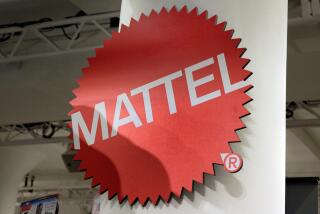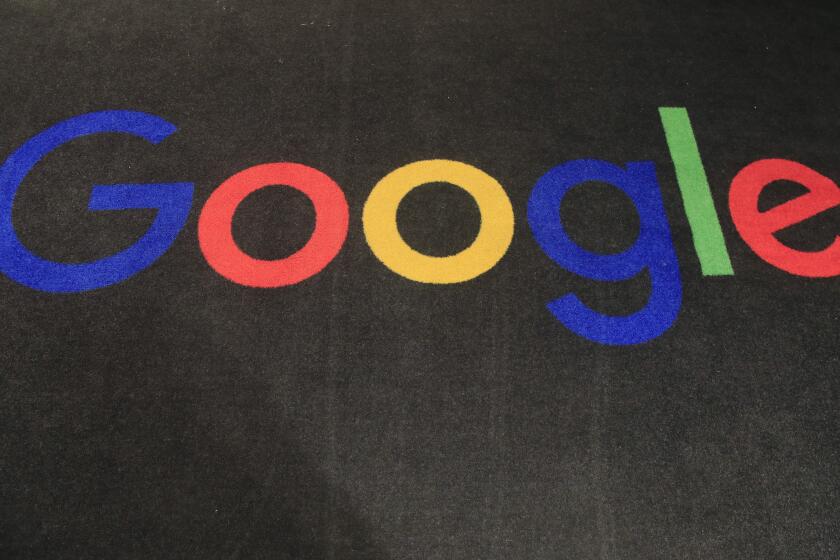Toy Industry Slams the Door on Those Who Built It: Amateur Inventors
- Share via
The American toy industry, once an entrepreneurial mix of clever marketing and lighthearted creativity, is not what it used to be. It’s more careful, more self-contained and more secretive. And although annual sales last year were at a record $13 billion, the field seems to be dominated by a few large companies. Despite a boom in the number of children under the age of 12, the industry is in the midst of a shakeout.
Among the casualties of all this are the amateur inventors, the tinkerers who were once the lifeblood of the industry. Now many have become the victims of their own business naivete, the toy industry’s fear of patent suits and the competition for retail shelf space.
Many of the smaller toy companies began going out of business and merging into larger companies when the first wave of high-tech toys in the late 1970s saturated the market and companies everywhere suffered greatly for heavy investments in a market that then went flat. They also suffered at the hands of large toy store chains that used their buying clout to force down prices from manufacturers; in the process, they forced out of business many of the independent toy retailers across the country.
In the past few years, even some of the larger companies have vanished. Coleco Industries Inc. filed for a reorganization under the U.S. Bankruptcy Code. So did Worlds of Wonder Inc., whose Teddy Ruxpin products swept the market three years ago. Milton Bradley Co. was bought by Hasbro Inc., now the largest and most diversified toy company in the country. Ideal Toys was purchased by Tyco Toys Inc.
“There has been a condensing of the toy industry,” said Robert Rao, senior vice president of marketing and product development for Mattel Inc. “There used to be dozens of second- and third-tier companies. Now that just doesn’t exist.
“There are very few $25- to $50-million companies any more, and even fewer $50- to $100-million companies,” he said. It was in these companies that “the independent inventor found a home.”
For the amateur inventor, the toy companies have become all but inaccessible.
“It’s important that we really get to the purpose of our business and not waste time on weak ideas,” said Leslie DiFranco, manager of research and development services at Fisher-Price, the leader in the market for infant and preschool toys.
“We have found that the casual inventor’s ideas often are not really right for what we are trying to put on the market,” DiFranco said. “And, unfortunately, the society that we live in today tends to resolve its conflicts in court, which can get very costly.”
The conflicts that worry DiFranco are patent infringement suits filed by inventors who claim their ideas were stolen by manufacturers that initially feigned disinterest. While cases of large magnitude are rare--such as the $24.8 million awarded to an inventor last month in Chicago for a patent infringement claim against Mattel for the flexible track used in its best-selling product, Hot Wheels--they have soured the relationship between companies and inventors.
“If anything,” DiFranco said, “they make us more sure that what we are doing, that being so careful, is the right thing to do.”
As toy executives see it, the inventors do not understand that even if they send an idea to a toy company, and the toy company comes out with something similar the following year, it does not mean that the concept for that product came from that particular inventor’s idea.
“We average something over 100 letters a week from would-be game developers,” said Michael Meyers, senior vice president for research and development for Milton Bradley. “We basically don’t look at them. If you do, you are exposing yourself to all kinds of legal problems. People think, ‘I sent the letter, so you know what’s in it.’ We have to erect walls around ourselves.”
Fisher-Price alone receives about 2,000 unsolicited ideas each year, despite the company’s efforts to discourage such submissions. Other toy companies report similar numbers. DiFranco said two people work part-time to return unopened packages and answer queries, which often means referring the person to the Toy Manufacturers of America Inc. in New York or to a reputable toy broker who can act as an intermediary between the company and the inventor--a route many inventors avoid because they don’t want to share their royalties for the credit for their ideas.
Toy companies also receive a number of letters from children who have ideas for toys--letters especially hard to handle. On one hand, the toy companies cannot use these ideas; on the other hand, they do not want to discourage what may be a creative young mind. “We have a specific letter that we send to them without all the legal terminology we would send to an adult,” DiFranco said. “We try to encourage them to continue the fine efforts.”
Because the toy industry is, in effect, a fashion industry, dominated by consumer tastes and marketing fads, companies cannot afford to be totally insulated from the outside reality of children, television and trends. They must deal with outsiders to some degree.
But almost without exception, toy companies will deal with only the so-called professional inventing community: Perhaps 100 to 125 people in the country who design toys for a living, have proven themselves trustworthy, productive and knowledgeable about how the industry works.
Richard Levy, a Bethesda, Md.-based professional inventor who has marketed through toy companies a number of successful products, such as Adverteasing and Hot Lixx Guitars, said companies do not believe they are losing anything by ignoring the smaller inventors.
“Companies don’t want products, they want lines,” Levy said, referring to a whole series of products based on a single character or concept. “The amount of money it takes to launch a product is astronomical, and they want to be sure they are in it for the long haul.”
Levy recently published “The Inventing and Patenting Sourcebook,” a large reference book that outlines some of the basics of marketing an invention. He published it, he said, because small inventors, being a generally frustrated and unsuccessful group, are especially prone to the dangers of some disreputable invention marketing firms that often advertise on late night television trying to get money from unwitting inventors. They ask exorbitant fees and accomplish nothing, Levy said.
The success of Nintendo also doesn’t help the independent inventor, he said. “When Nintendo comes on the market and captures a billion dollars of the industry, it’s not good for anything,” he said.
Toy analyst Paul Valentine, who follows toy company stocks for Standard & Poor’s in New York, agreed: “It been a rough couple of years for the American toy industry,” he said. “Nintendo has really eaten their lunch--it’s diverting attention away from traditional toys.
“There is a complaint in the industry that there is not enough willingness to take a risk,” Valentine continued. “I think all the toy companies realize that they have to be more creative and agile than they have been in the past.”
Gary Niles, senior vice president at Lewis Galoob Toys Inc., a $200-million-plus company in California, understands why the larger companies are so unwilling to take risks.
“Take a company like Mattel that has the Barbie brand and the Hot Wheels brand--why do they have to take risks?” he said. “They can reinvest in their existing products, extend their lines and know they will make money.”
Mattel’s Rao conceded that while it does sometimes happen, it is hard for a free-lance inventor to feed the company’s core brands.
The executives of toy companies today, Niles said, are not the entrepreneurial inventors who began the toy industry.
“These people are professional brand people, not professional toy people,” he said. “The inventor who brings in revolutionary things can probably not even be appreciated by these people.”
Niles said second-tier companies, such as Kenner Products of Cincinnati, which has revenue of about $600 million to $800 million, buy expensive licenses to marketing concepts that are already proven commercial successes, such as movie characters Robocop and Ghostbusters, rather than deal with the expense and risk of introducing untested products.
Because the industry has changed so much, it is easy for toy executives and inventors to talk about the old days. But the old days for the toy industry are not so long ago.
David Doyle, a scientist and former inventor who lives in Boston, was able to break into the toy market fairly easily in the late 1970s. His inventions were electronic, and he hit the market just as the entire industry was jumping on the high-tech bandwagon.
“To come to the toy industry was ideal,” Doyle said. “They had a standard channel for going in and talking to a senior vice president for research and development. And there was a relatively agreed on royalty rate.”
In 1978, Parker Bros. brought out one of Doyle’s games, Merlin, and it was an immediate success. Merlin and Simon, electronic games that required the player to repeat an increasing series of tones or light pulses, appeared together on a cover of Newsweek that year, testimony to the effect high-tech games were having on the toy market. In 1979, Doyle said, practically every toy company entered the business of electronic games.
“Then we went into another whole technology era,” he said. “The toy companies wished they didn’t have to pay royalties to independent inventors.
“By 1980, the (toy companies) were begining to develop products in-house,” Doyle said. Where the industry was once welcoming outsiders, it became “unwilling to talk to anyone other than the so-called professional inventing community.”
In-house design groups today are generally quite large, particularly those of the bigger firms. Fisher-Price has a sizable design group, DiFranco said, which the company keeps insulated from outside designers to protect against possible idea overlap.
Hasbro has more than 100 people in its research and development group. Mattel has more than 400.
Michael Rounds, who conducts seminars in Los Angeles for thousands of inventors every year, said the industry has a bad taste in its mouth from the great influx of inventors that helped make the high-tech boom what it was. Now, he argued, it is scared of the entrepreneurial spirit.
“The leading edge stuff is going” to foreign manufacturers, he said. “Nintendo made a huge commitment in a high-risk field. No toy manufacturer in the country would make that kind of commitment (today).”
One of Rounds’ inventor students, Wendy Cutler, came up with a toy designed for parents who make long drives with children.
Cutler, who like most amateur inventors said she is “always coming up with silly ideas for things,” will not reveal what her toy is before it is shown for the first time at the annual toy fair in February. After two years of having drawings and prototypes done, after spending thousands of dollars researching and getting a patent on her toy, she is not about to let someone else take her idea. Cutler is also one of the lucky ones: After she spent three weeks trying to get through to Mattel and was rejected by another fairly large company in California, she found a small company, Placo Products Co. in Los Angeles, that decided to take on her product.
She entered into a contract with the company, she said, at a healthy 8% royalty rate (most royalty rates are 3% to 4% and often have to be split with a broker or another design firm).
But while dealing with a smaller company gives her a more generous royalty and more control over the modifications that may be made on her toy, it does not necessarily guarantee that Cutler will make more money.
She realizes that Placo, because of its size, will likely not have a large enough budget to advertise on television--a crucial marketing tool in the toy business.
Still, like most amateurs, Cutler is a determined optimist, hoping her good idea will largely sell itself. She even has planned what she will do with her royalty check if the toy becomes a hot seller: She’ll buy a new house.
More to Read
Inside the business of entertainment
The Wide Shot brings you news, analysis and insights on everything from streaming wars to production — and what it all means for the future.
You may occasionally receive promotional content from the Los Angeles Times.










